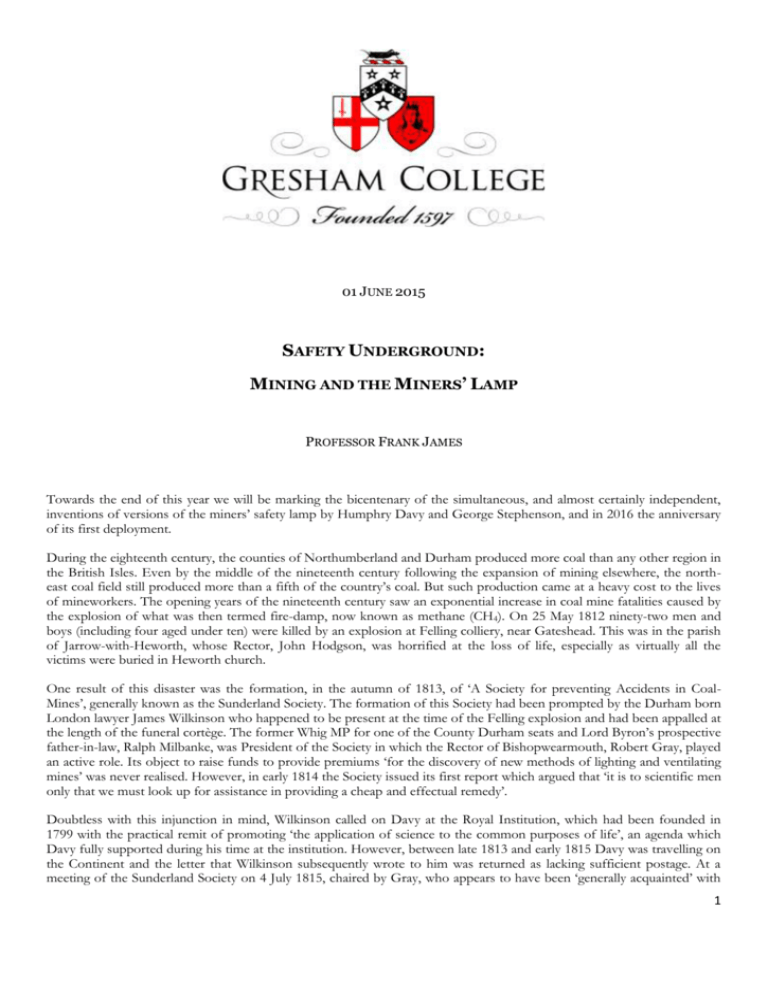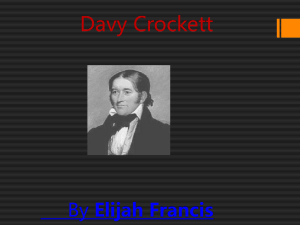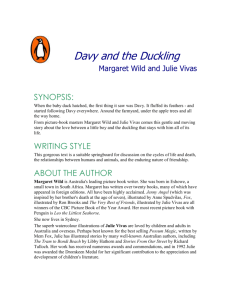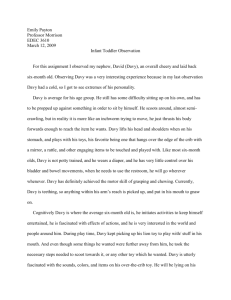Transcript for "Safety Underground: Mining and the Miners` Lamp"
advertisement

01 JUNE 2015 SAFETY UNDERGROUND: MINING AND THE MINERS’ LAMP PROFESSOR FRANK JAMES Towards the end of this year we will be marking the bicentenary of the simultaneous, and almost certainly independent, inventions of versions of the miners’ safety lamp by Humphry Davy and George Stephenson, and in 2016 the anniversary of its first deployment. During the eighteenth century, the counties of Northumberland and Durham produced more coal than any other region in the British Isles. Even by the middle of the nineteenth century following the expansion of mining elsewhere, the northeast coal field still produced more than a fifth of the country’s coal. But such production came at a heavy cost to the lives of mineworkers. The opening years of the nineteenth century saw an exponential increase in coal mine fatalities caused by the explosion of what was then termed fire-damp, now known as methane (CH4). On 25 May 1812 ninety-two men and boys (including four aged under ten) were killed by an explosion at Felling colliery, near Gateshead. This was in the parish of Jarrow-with-Heworth, whose Rector, John Hodgson, was horrified at the loss of life, especially as virtually all the victims were buried in Heworth church. One result of this disaster was the formation, in the autumn of 1813, of ‘A Society for preventing Accidents in CoalMines’, generally known as the Sunderland Society. The formation of this Society had been prompted by the Durham born London lawyer James Wilkinson who happened to be present at the time of the Felling explosion and had been appalled at the length of the funeral cortège. The former Whig MP for one of the County Durham seats and Lord Byron’s prospective father-in-law, Ralph Milbanke, was President of the Society in which the Rector of Bishopwearmouth, Robert Gray, played an active role. Its object to raise funds to provide premiums ‘for the discovery of new methods of lighting and ventilating mines’ was never realised. However, in early 1814 the Society issued its first report which argued that ‘it is to scientific men only that we must look up for assistance in providing a cheap and effectual remedy’. Doubtless with this injunction in mind, Wilkinson called on Davy at the Royal Institution, which had been founded in 1799 with the practical remit of promoting ‘the application of science to the common purposes of life’, an agenda which Davy fully supported during his time at the institution. However, between late 1813 and early 1815 Davy was travelling on the Continent and the letter that Wilkinson subsequently wrote to him was returned as lacking sufficient postage. At a meeting of the Sunderland Society on 4 July 1815, chaired by Gray, who appears to have been ‘generally acquainted’ with 1 Davy, it was resolved to approach him again about preventing explosions in mines. Gray’s letter has not been found, but judging by Davy’s reply sent from Melrose on 3 August 1815, he had asked Davy if there were any chemical means of destroying fire-damp. On his way south Davy spent some time in the north-east, collected sample of fire-damp which he had bottled and sent to London for future analysis. During the week beginning 9 October, Davy, helped by the Royal Institution’s laboratory assistant, Michael Faraday, commenced an intense period of research on the problem. By the end of the month, Davy believed that he had developed a safe lamp which was basically a standard horn lamp with very narrow glass tubes acting as a chimney. He worked on the principle of endeavouring to construct a lamp which would allow light to pass, but would reduce the temperature of the heat reaching the surrounding atmosphere to below the point which would ignite the fire-damp. He told his patron, the President of the Royal Society of London, Joseph Banks, of his work for which Banks congratulated him heartily ‘on defending Society from a Tremendous Scourge of humanity’. With the same principle in mind Davy developed other lamps with a variety of chimney shapes (some with bimetallic valves) and lamps where their air was delivered by bellows, syringes or multiple narrow air intakes. So confident was he of having achieved success that it was agreed his paper describing the lamps would be read to the Royal Society of London on 9 November and the prototype lamps were displayed in Banks’s Soho Square house. Although the figures for Davy’s paper were engraved (at some expense) for publication in the Philosophical Transactions, the paper as read was never published since Davy and Faraday continued work and soon developed the idea of what Davy called a fire sieve. This was a series of nested metal cylinders or rectangles, which would absorb the heat and thus reduce the external temperature of the lamp. From this it was only a short time before Davy realised that the same effect could be obtained by just using wire gauze, tell Hodgson right at the end of December: When a candle or lamp is enclosed in a wire gauze cylinder & introduced into an explosive mixture the flame of the wick is extinguished but the mixed gas burns steadily within the wire gauze vessel. … I can confine this destructive element flame like a bird in a cage. A few days later, Davy sent Hodgson five of his lamps on and 9 January 1816, Hodgson with others descended into Hebburn colliery (also in his parish) to test the lamps which was entirely successful. Reports of Davy’s lamp had started circulating by early November and this prompted very early that month an announcement at a meeting of the Newcastle committee for the coal trade that Stephenson since September had been developing and using a safe lamp in Killingworth colliery where he was engineer. Like Davy’s lamp, Stephenson’s underwent developments through October and November (though these are less well documented than Davy’s) and by the middle of that month, it was clear that there was room for a serious priority dispute. Davy visited the north-east twice during 1816 and the triumphalist attitude he displayed towards his lamp and highly dismissive views of Stephenson’s, turned the dispute acrimonious and personal. In the north-east Davy had considerable establishment support from figures such as Gray, Hodgson, the Bishop of Durham, and John Lambton (later Earl of Durham) whom as a small boy studying with Thomas Beddoes in Bristol Davy had known well; he was also immensely wealthy. He told Lambton ‘I hope you will not blame me for not taking any notice of the attacks of my enemies in the North. I have no desire to go out of my way to crush gnats that buzz at a distance, and do not bite me, or to quarrel with persons who shoot arrows at the moon’. To have taken public notice of Stephenson would have invited comment on Davy’s work; much better to remain silent in public and abuse him in private. In a clearly concerted move to outflank Stephenson, on 11 October 1817 a powerful group of mine owners, led by Lambton, publicly presented Davy with plate worth £2500 while the following month Banks and other officers of the Royal Society of London issued a statement from Banks’s house rebutting all of Stephenson’s claims. Stephenson’s supporters could only raise 600 guineas and there was no possibility that Stephenson could either follow or contradict the rhetoric emanating from Soho Square. From this controversy emerged the idea, expressed by Faraday, that the Davy lamp was a ‘mark of subjection set by Science in the strongest holds of nature’. Quite what was scientific about the lamp is not clear, but claiming it for science, helped undermine Stephenson’s position, since, as someone with no scientific background at all, he could not have made the same claim. One consequence of the controversy was that Davy refrained from seeking to patent his lamp in case Stephenson mounted a successful challenge. Instead Davy adopted the rhetoric of giving his invention freely for the benefit of humanity. In terms of its practical impact, aside from saving lives, both lamps allowed for the exploitation of deeper coal seams (where there was more fire-damp) and thus an increase in production. The statistics for the north-east coal field for the number of miners killed per million tons of coal extracted shows equally steep exponential rise and fall either side of 1815 and a continuing, gradual, decline thereafter, except for 1844. On 28 September that year a major explosion at Haswell 2 colliery, County Durham, killed ninety five men and boys (none under ten). The Haswell colliery explosion for a number of reasons has commanded considerable interest and concern both at the time and more recently. Haswell was a modern mine, owned by a company rather than an individual, such as Lambton or the Marquis of Londonderry, and it had recently been at the centre of prolonged and bitter strike. The disaster was discussed by Friedrich Engels in his Condition of the Working Class in England, published the following year, while the Illustrated London News carried a number of images including of the long funeral cortège. At the inquest the families were represented by the Chartist, trade union leader and lawyer William Roberts. During a break in the inquest Roberts travelled to Brighton to petition the Tory Prime Minister Robert Peel to appoint two independent scientific experts to assist the coroner. This procedure had been recommended by a House of Commons committee in 1835, but it seems had not so far been implemented. Due to the intense publicity surrounding the disaster, Peel had little option but to agree. The experts, appointed by the permanent secretary at the Home Office, were Faraday (now Fullerian Professor of Chemistry at the Royal Institution) and the geologist Charles Lyell. In his letters of appointment the permanent secretary anticipated the inquest verdict by referring to the explosion as an ‘accident’. This was important as such a verdict would mean that the mine owners would not be liable to pay compensation to the families of those killed. Faraday and Lyell travelled to the north-east where they sat next to the coroner at the inquest and spent a day in Haswell colliery. Faraday was appalled at the lax safety procedures there. For example he found himself sitting on a bag of gunpowder while a naked candle was in use. Nevertheless the jury found that the explosion was an accident, a verdict with which Faraday agreed. However, owing to a vaguely worded paragraph in their letters of appointment, Faraday and Lyell wrote a report which made a number of recommendations including that fire-damp should be drawn away from mines by specially constructed conduits and that mine workers should be provided with better education. A major political row ensued over the expense which implementing such proposals would entail. With Peel coming under considerable pressure from both sides, Faraday’s and Lyell’s report was tabled in the House of Commons on the day of the second reading of the highly controversial Maynooth grant bill, and their report and its recommendations were thus smothered. The evidence from both these episodes illustrates the wide range of interests and knowledge involved in mining safety. Religious, political, legal, economic, rhetorical, business, media, scientific and engineering considerations all played their part. Mostly working for an avowed benefit for humanity (though occasionally not), these interests during the nineteenth century and beyond cohered to improve safety in mines, to reduce the frequency between the necessity for long cortèges and at the same time increase coal production which allowed a continued expansion of industrialisation. Safety was not, is not, a stand-alone issue, but an integral part of culture and society. Further reading: Frank A.J.L. James. ‘How Big is a Hole?: The Problems of the Practical Application of Science in the Invention of the Miners’ Safety Lamp by Humphry Davy and George Stephenson in Late Regency England’, Transactions of the Newcomen Society, 2005, 75: 175-227. Frank A.J.L. James and Margaret Ray, ‘Science in the Pits: Michael Faraday, Charles Lyell and the Home Office Enquiry into the Explosion at Haswell Colliery, County Durham, in 1844’, History and Technology, 1999, 15: 213-31. © Professor Frank James, June 2015 3




